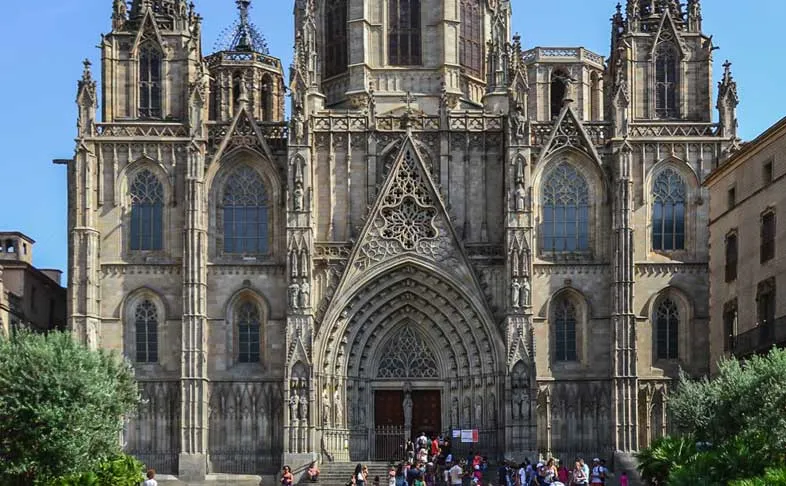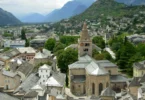Introduction
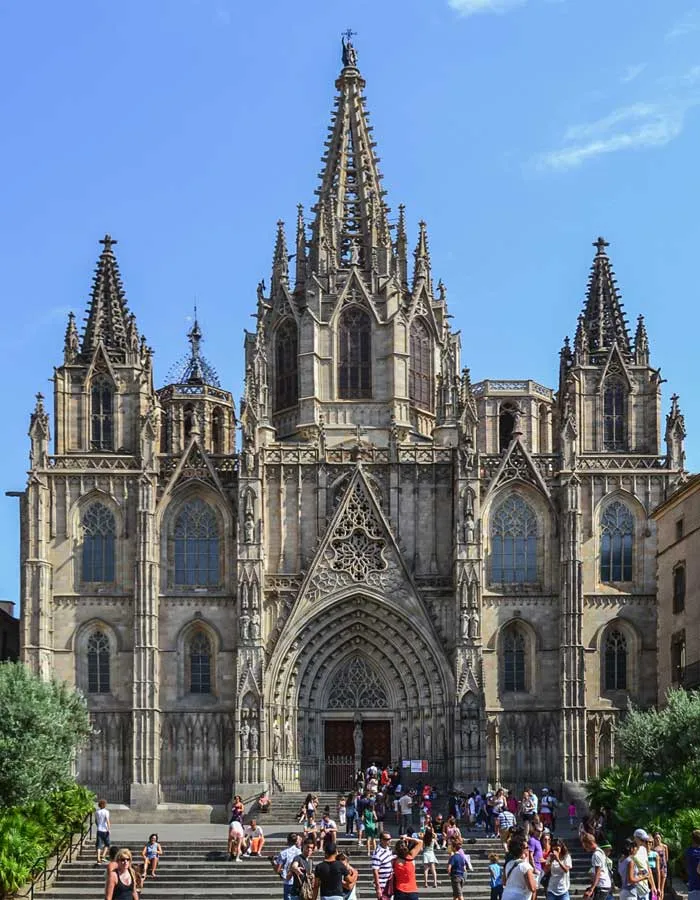
The Cathedral of the Holy Cross and Saint Eulalia (Catalan: Catedral de la Santa Creu i Santa Eulàlia), also known as Barcelona Cathedral, is the Gothic cathedral and seat of the Archbishop of Barcelona, Catalonia, Spain. The cathedral was constructed from the thirteenth to fifteenth centuries, with the principal work done in the fourteenth century. The cloister, which encloses the Well of the Geese (Font de les Oques), was completed in 1448. In the late nineteenth century, the neo-Gothic façade was constructed over the nondescript exterior that was common to Catalan churches. The roof is notable for its gargoyles, featuring a wide range of animals, both domestic and mythical.
Its form is pseudo-basilica, vaulted over five aisles, the outer two divided into chapels. The transept is truncated. The east end is a chevet of nine radiating chapels connected by an ambulatory. The high altar is raised, allowing a clear view into the crypt.
The cathedral is dedicated to Eulalia of Barcelona, co-patron saint of Barcelona, a young virgin who, according to Catholic tradition, suffered martyrdom during Roman times in the city. One story says that she was exposed naked in the public square and a miraculous snowfall in mid-spring covered her nudity. The enraged Romans put her into a barrel with knives stuck into it and rolled it down a street (according to tradition, the one now called Baixada de Santa Eulàlia). The body of Saint Eulalia is entombed in the cathedral’s crypt.
The choir stalls retain the coats-of-arms of the knights of the Order of the Golden Fleece. In his first trip into Spain, Charles, the future Holy Roman Emperor, selected Barcelona as the site of a chapter of his Order. The king had arrived for his investiture as Count of Barcelona, and the city, as a Mediterranean port, offered the closest communication with other far-flung Habsburg dominions, while the large proportions of the cathedral would accommodate required grand ceremonies. In 1518 the Order’s herald, Thomas Isaac, and its treasurer, Jean Micault, were commissioned to prepare the sanctuary for the first sitting of the chapter in 1519. Juan de Borgonya executed the painted decoration of the sanctuary.
“The church was named after Barcelona’s patron saint Eulalia; its official name – Catedral de la Santa Creu i Santa Eulàlia – is Catalan for “Cathedral of the Holy Cross and Saint Eulalia”. The commonly used name La Seu refers to the status of the church as the seat of the diocese.”
The side Chapel of the Holy Sacrament and of the Holy Christ of Lepanto contains a cross said to date from the time of the Battle of Lepanto (1571).
In addition to Saints Eulàlia and Olegarius, the cathedral contains the tombs of Saint Raymond of Penyafort, Count Ramon Berenguer I and his third wife Almodis de la Marche, and bishops Berenguer de Palou II, Salvador Casañas y Pagés, and Arnau de Gurb, who is buried in the Chapel of Santa Llúcia, which he had constructed.
The cathedral has a secluded Gothic cloister where 13 white geese are kept, the number explained by the assertion that Eulalia was 13 when she was martyred.
A program of cleaning and restoration of the cathedral was carried out from 1968 to 1972.
History of Barcelona Cathedral
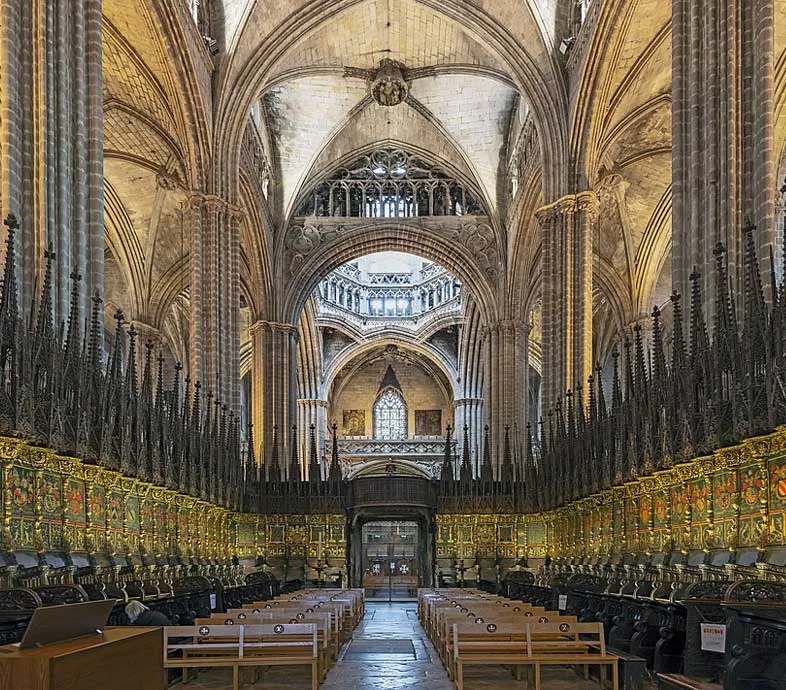
Parts of an early Christian and Visigothic episcopal complex including the baptistery (fourth century), a basilical hall (fifth century), a cross shaped church (sixth-seventh century) and bishop’s palace (sixth-seventh century) are displayed in Barcelona City History Museum archaeological underground. Reportedly, this Visigothic chapel was dedicated to Saint James, and was the proprietary church of the Viscounts of Barcelona. However, in a document from the Second Council of Barcelona in 599, it states that the cathedral was dedicated to the Holy Cross. This church was severely damaged by al-Mansur (Almanzor) during his attack on Barcelona in 985.
In 1046, Count Ramon Berenguer I and his wife Almodis, together with Bishop Guislabert, began construction of a Romanesque cathedral at the site; it was consecrated in November 1058. The cathedral was constructed over the crypt of the former church. It has been reported that a Viscount of Barcelona, Mir Geribert, sold the site to Bishop Guislebert in 1058, though however, this date does not coincide with the reported start of construction.
The present Gothic cathedral was begun on the foundations of the previous churches on 1 May 1298; James II the Just was King of Aragon at the time, and Bernat Pelegri was Bishop of Barcelona. The church was built from the east end towards the west end, with a simple west facade completed in 1417. The cloister was completed in 1448, making the total duration of construction 150 years. In the late nineteenth century, Miguel Girona i Agrafel offered to complete the neo-Gothic facade and central tower as inspired by the original fifteenth-century design prepared by master Carlí and rearranged and drawn by the architect Josep O. Mestres. This work was completed in 1913 by Girona’s children.
Architecture
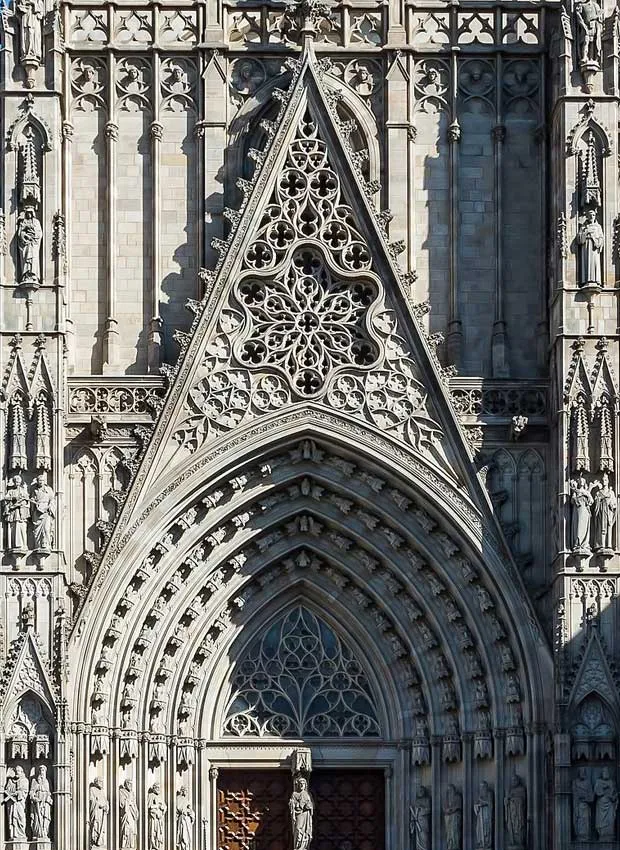
Barcelona Cathedral has three naves, but with a single apse and ambulatory, or girola. The ships have five sections; the section immediately on the facade is longer than the other three, to accommodate its dimensions to those of the dome that rises behind the main door.
The typical Catalan Gothic architectural structure, ordered to take advantage of the interior spaces of the buttresses, allows a series of secondary chapels to open towards the interior of the Cathedral, which surround the entire basilica: in the naves, these chapels are two for each section.
On the ends of the section close to the presbytery, free of side chapels, rise the two large bell towers, one over the portal of Sant Lu and one over the inner door of access to the cloister; on the terraces of the basilica, these towers are octagonal, with a prismatic body, intended for scale, which is attached to them (1386-1393 and 16th century).
Large windows, open over the mouth of the radial chapels of the girola, illuminate the presbytery. Above the chapels, in the side aisles, runs a high gallery with open windows on the exterior wall of the basilica. A small triforium surrounds the central nave, and the presbytery, ran the vault.
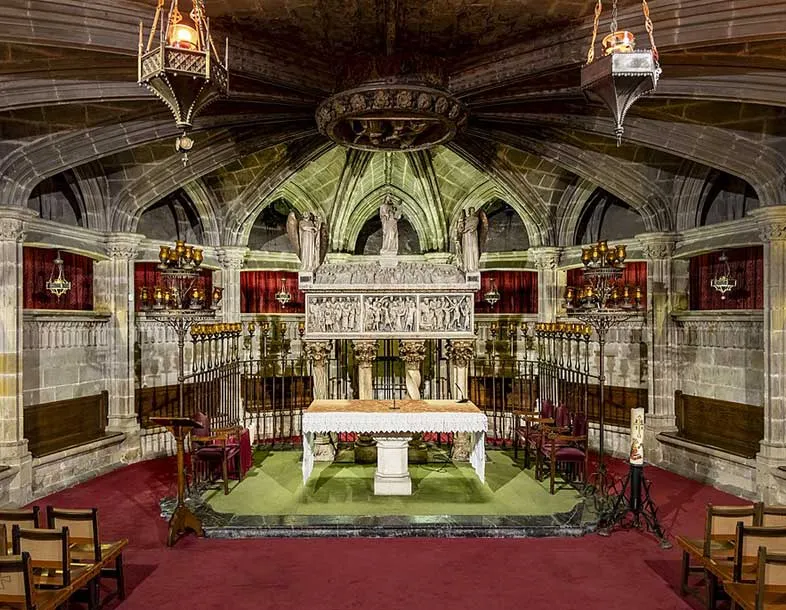
Dimensions
The outside dimensions of the Cathedral are 93 meters long, 40 wide and 28 high in the central nave. The bell towers rise up to 54 meters. The dome is 70 meters high on the outside, and 41 meters on the inside.
The interior dimensions of the Cathedral, not counting the chapels on each side, are 79 meters long and 25 meters wide; the entrance to each chapel is 9 meters high, 5 meters wide and about 6 meters deep. The central nave is 13 meters wide and 26 meters high; the lateral ships are 6 meters wide and 21 high; the pillars, standing flat up to the beginning of the arches, are 15 meters high.
Painting

Gothic altarpieces made by Guerau Gener, Lluís Borrassà, Gabriel Alemany and Bernat Martorell, among others, are preserved in the chapels of the Cathedral.
The Cathedral Museum preserves Gothic paintings by artists such as Pere Destorrents, Jaume Huguet, or Bartolomé Bermejo, author of La Pietat.
Decorative Arts - Custody
Custody is one of the treasures of the Cathedral; made in gold and silver, it is adorned with jewels that were an offering of deep-rooted popular devotion. From the middle of the s. XV, King Martí’s chair, made of gilded silver, acts as a pedestal for the custody. This chair gets its name because it is a supposed legacy or gift from King Martí the Human, and dates from the s. XIV.
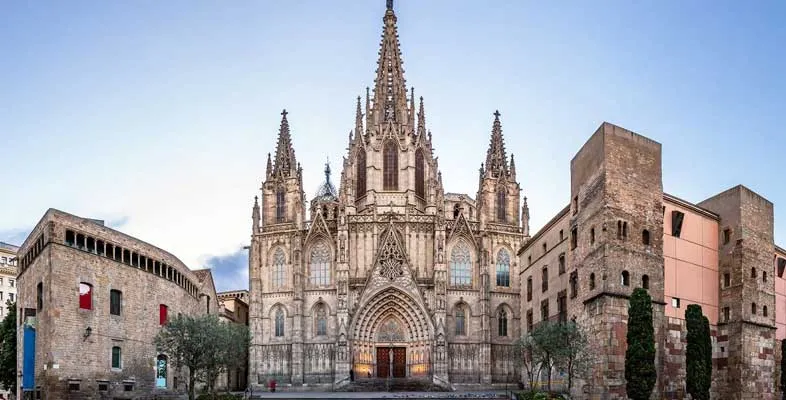
Chair of the Heart
The choir stalls of the Cathedral date from the 14th and 15th centuries. The shields of the Order of the Golden Fleece, from the s. XVI.
In this set, the trona, the work of Pere Çanglada and Maties Bonafé, with the collaboration of Antoni Claperós and John Lambert, made between 1394 and 1499, also stands out. The high canopies in the form of pinnacles, from the year 1499, they are the work of the artists Kassel and Michael Lochner.
The back room is closed with a marble wall with reliefs from the s. XVI, made by Bartolomé Ordóñez and Pedro Villar.

The Keys Back
- The Cathedral has a total of 215 keystones, dating from the 14th and 15th centuries.
- They were restored in 1970, which made it possible to discover that they were polychrome.
- The vault keys of the central nave starting with the presbytery are:
- Christ crucified between the Virgin and Saint John with the symbols of the sun and the moon.
- Santa Eulàlia with the coat of arms of Blanca of Naples, wife of Jaume II. Dated 1320.
- Virgin of Mercy, welcoming in her cloak, on one side, a pope, a king, a cardinal, a bishop and a canon, on the other side the queen, a nun and three other female figures. Date of 1379.
- The Annunciation. The Virgin with the Archangel Gabriel. Year 1379.
- A bishop with deacons, believed to be Bishop Pere Planella (1371-1385), because his shield is on the side of the key.
- Eternal Father surrounded by angels, by the sculptor Pere Joan made in 1418.
Another great key is the one found in the crypt of Santa Eulàlia, representing the saint with the Virgin and the Child. Near the door of Sant Iu, its key represents Sant Pere, surrounded by four other smaller trilobed ones; at the exit door to the cloister, on the opposite side, it represents Saint John with the eagle, also surrounded by four other smaller ones.
The Stained Glass Windows
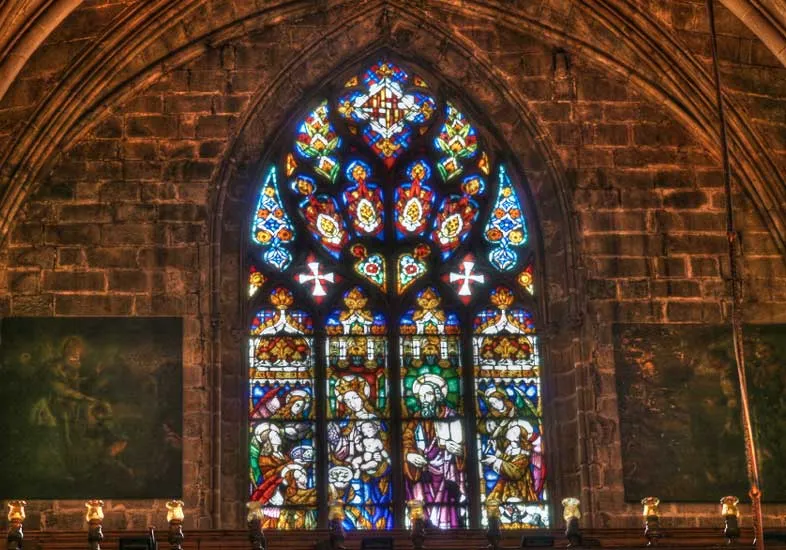
The Cathedral has numerous Gothic and modern stained glass windows. They all follow the same scheme of three streets, the central one with the image of the holder and the lateral ones with geometric decorations that frame royal coats of arms, of the city, angels, etc. and trilobed crown.
The stained glass eras can be divided into four parts: The first, dated to the years 1317-1334, by the coat of arms of Bishop Ponç de Gualba that can be seen in the stained glass windows of Santa Creu and Santa Eulàlia, includes all the stained glass windows of the header, on the radial chapels. In addition to this, the one of Sant Pere, the one of Pope Sant Silvestre where on the sides there are heads of holy bishops by the author called Mestre de Sant Silvestre made in 1386 and the one of Sant Esteve.
The second stage, around the year 1400, are those at the ends of the apse: Sant Andreu with the shields of Bishop Armengol from the year 1398/1408, and that of Sant Antoni Abbot, made by Nicolau de Maraya in the years 1405-1407.
The third stage is the stained glass windows made during the 15th century, such as the stained glass window of Saint Michael the Archangel and the most important one, called Noli me tangere, located in the chapel of the baptistery, is the work of Gil de Fontanet, with cartoons drawn by Bartolomé Bermejo, from the year 1495.
The fourth stage spans from the end of the s. XIX at the end of the s. XX and includes the windows on the facade and on the side walls.
The Temple and the Cloister

The cloister of the Cathedral is in Gothic style, and was built between the 14th and 15th centuries, by architects such as Andreu Escuder and sculptors such as Antoni Claperós.
The cloister is accessed through the exterior doors of Pietà and Santa Eulàlia. The inner cloister door, which connects the cathedral with the cloister, is Romanesque in white marble, and has archivolts decorated with geometric motifs and a Gothic-style tympanum. It has been said that it came from the previous Romanesque cathedral.
The cloister has a quadrangular plan, and consists of four galleries of ogival arches separated by pillars. Scenes from the Old Testament and a legend about the Holy Cross can be seen carved into the reliefs of the pillars of the arches of the cloister, and scenes from the New Testament on the vault keys.
In three of its galleries, there are chapels, which were initially under the patronage of the patron of some institution or guild, or under the protection of some family. All these chapels are covered with cross vaults, most of which are quadripartite, with vault keys at the junction of the nerves.
In the center of the cloister, there is a garden with palm trees, magnolias, an orange tree, and a fountain dating from the mid-15th century, where the traditional ” dancing egg” takes place on the occasion of the Corpus Christi festival. In a large pool in the cloister, the thirteen white geese of the Cathedral play.
The Roofs

Through the Sants Innocents chapel, next to the Porta de Sant Iu, you can access the roofs with a lift. From the roofs you can see the two bell-towers, the two lateral Gothic domes, the dome crowned by the Holy Cross supported by the image of Saint Helena, the cloister and a very interesting panorama of Barcelona.
Heart with the Golden Fleece saddle
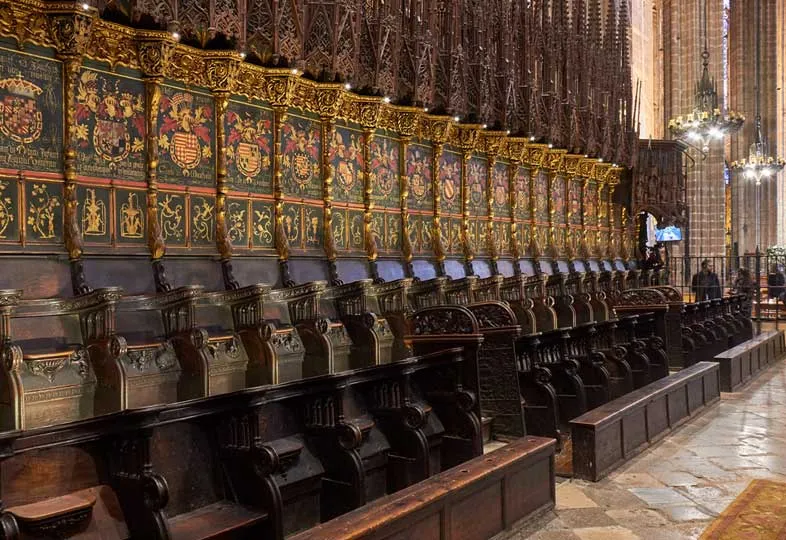
The heart of the Cathedral began to be built in 1390, under the mandate of Bishop Ramon d’Escales, whose coat of arms can be seen on the outer face of the side walls.
The cadirat constitutes one of the most remarkable sculptural ensembles of the Gothic style in Catalonia. The canopies and pinnacles were made by the sculptor Michael Lochner and his disciple Johan Friedrich at the end of the 15th century. From the years 1517-18 are the commemorative shields that Joan of Burgundy painted on the backrests of the high chair, and which correspond to the knights of the Order of the Golden Fleece, summoned by their great Master, Emperor Charles V, which met in Barcelona in March 1519.
At the entrance to the choir, on the right, is the wooden throne, carved by the sculptor Pere Çanglada in 1403. The rear choir was begun in 1519 by the sculptor Bartolomé Ordóñez. It is made as a Doric colonnade, crowned with a balustrade and, between its intercolumniations, there are four scenes sculpted in relief from the life of Saint Eulàlia, two on each side of the door and, at its ends, niches containing body sculptures.
Chapter Room

The historic Chapter Hall of the Cathedral, which has become a museum space, is located in the same gallery of the cloister where the chapel of Santa Llúcia is located. Initially, it was where the old canteen for the poor was located.
From the collection of works found in the Chapter Room, the 11th century treboled baptismal font, from the old Romanesque temple, and the sculpture of Santa Eulàlia made in terracotta by Giuliano di Nofri should be highlighted , coming from the tympanum of the door of Santa Eulàlia. In terms of painting, we should highlight the Gothic altarpiece of Saint Bernard and the Guardian Angel, by the painter Jaume Huguet made between 1465 and 1470, and the Pietà, painting on table, work by Bartolomé Bermejo, from the year 1490, and also known as Piety of Canon Desplà. It highlights the custody, from the end of the 14th century, formed with the campaign throne of King Martí l’Humà.
Jewish Memory in the Cathedral
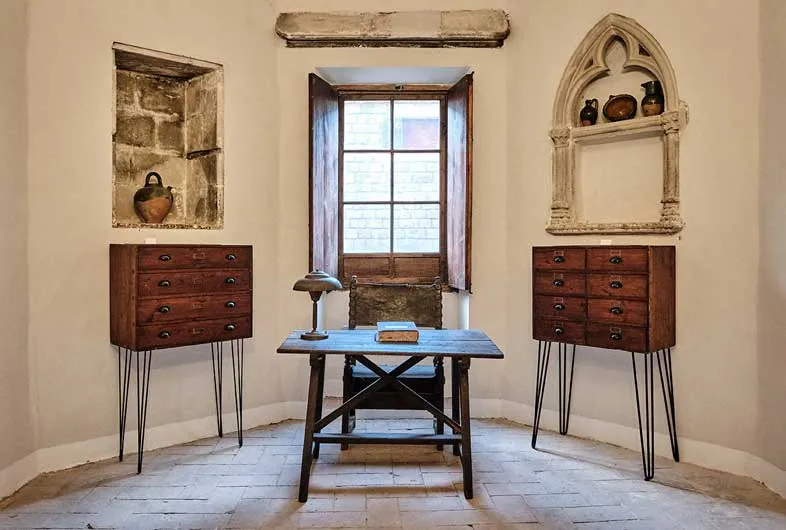
The Chapter Archive preserves thousands of scrolls and books that explain the history of the city. Part of this history is related to the Jewish community that has lived together and shares daily life with the other communities. Legal documents (purchases, rents, wills, etc.) preserved there help us to reconstruct the personal stories of the people who lived in the Call.
Entering the Ancient Archives of 1535, with a sample of original documentation (in Latin, Hebrew and Catalan), we approach written testimonies that give voice to the inhabitants of medieval Barcelona.
Chapel of Saint Christ in Lepanto
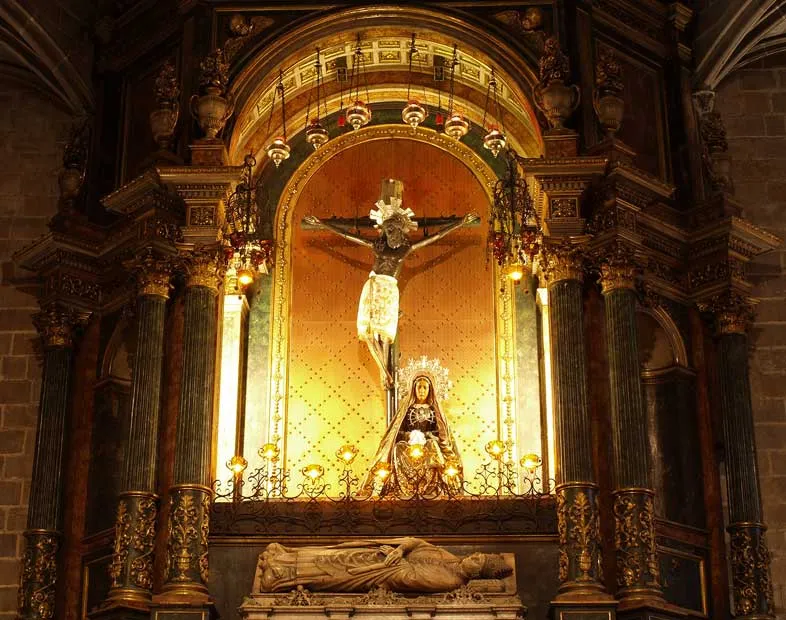
The Chapel of the Holy Sacrament and of the Holy Christ of Lepanto is a small side chapel constructed by Arnau Bargués in 1407, as the chapterhouse. It was rebuilt in the seventeenth century to house the tomb of San Olegarius, Bishop of Barcelona, and Archbishop of Tarragona.
The “Holy Christ of Lepanto” crucifix, is located on the upper part of the chapel entrance’s front façade. The curved shape of the body, of Our Lord Jesus Christ on the Cross, is explained by a Catalan legend which holds that the cross was carried on the prow of the galley captained by Juan of Austria, step-brother of Spanish Philip II of Spain during the Battle of Lepanto in 1571. When a cannonball flew toward the cross, it leaned out of the way in order to avoid being hit, and has been inclined ever since. The Habsburgs were said to have regarded this as an encouraging omen.
A separate story says that the cross was in the ship’s hold and that the figure moved to cover a large hole that would have sunk the ship.
The Organ
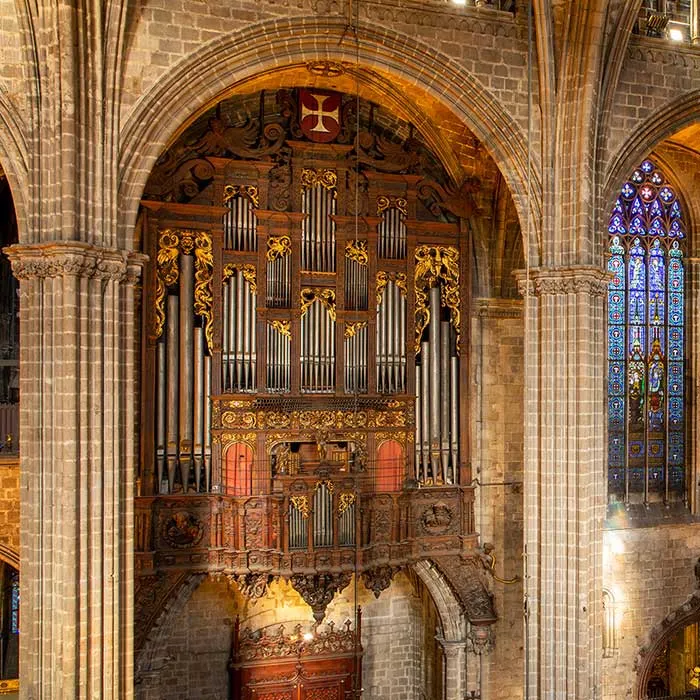
In the Cathedral of Barcelona, the organ accompanies the Eucharistic celebrations and the prayer of the Divine Office.
The Cathedral organ is of great artistic, liturgical and historical interest. It is located inside the nave, under the bell tower, in the upper gallery, above the Sant Iu portal. It was built between the years 1537 and 1539.
The box was closed with twills decorated with grisailles by the artist Pere Pau Serafí “el Grec”. These twills of the main organ are in the exhibition hall of the church of Sant Sever (at Carrer de Sant Sever, number 9), and in the Museum of the chapter house, in the cloister of the Cathedral.
Traditions
The tradition of the ‘dancing egg’ (supported by the jet of a fountain) is maintained on the day of Corpus Christi at the cathedral.
Present Day
The cathedral has been updated in response to an increasing number of tourists. The cloister now contains a gift shop, the traditional candles normally lit at the shrines of saints have been replaced with electronic candles, and cellular phones have been banned from the Chapel of Lepanto and other chapels.
Feast Day - 12th February
The Feast Day of the Barcelona Cathedral, also known as the Cathedral of the Holy Cross and Saint Eulalia, is celebrated on 12th February. Saint Eulalia is the co-patron saint of Barcelona, and her feast day is observed with various religious and cultural events in the city.
Mass Time
Weekdays
Saturdays
Sundays
Church Visiting Time
Contact Info
Pla de la Seu, s/n,
08002, Barcelona, Spain.
Phone No.
Tel : +34 933 42 82 62
Accommodations
How to reach the Cathedral
Barcelona–El Prat Airport is an international airport in Barcelona, Catalonia, Spain is the nearby Airport to the Cathedral.
Jaume I Metro Station in Barcelona, Spain is the nearby Train Station to the Cathedral.

